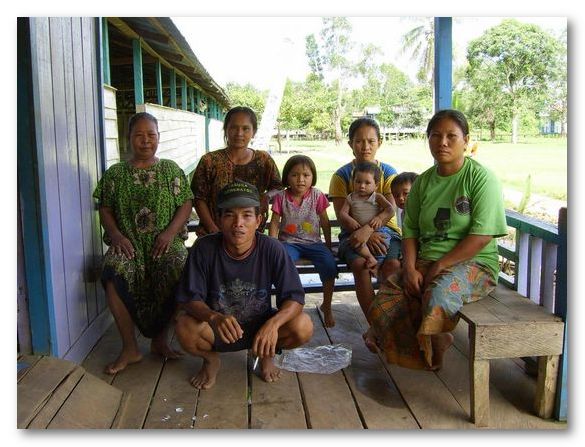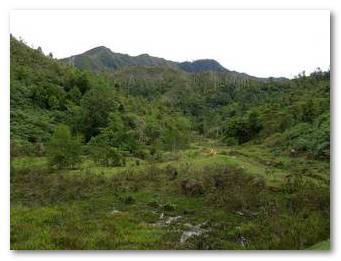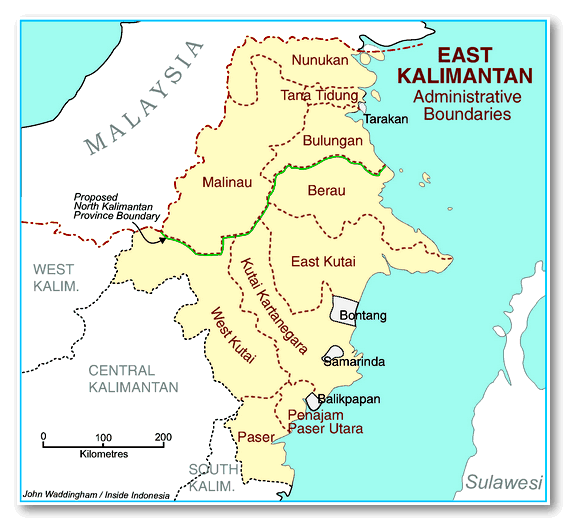Laurens Bakker
East Kalimantan administrative boundariesJohn Waddingham |
The first direct local elections have led to some unexpected developments for local land rights and land tenure security in East Kalimantan. With decentralisation legislation and direct elections of local leaders, unpopular policies and decisions can return to haunt these leaders at election times, providing a way for the region’s population to influence their local administration.
Paser’s oil palms
In 2001, local farmers occupied an oil palm plantation in Paser, East Kalimantan. A stalemate ensued, with occupying farmers claiming customary (adat) rights to the lands, on the one hand, and migrant workers and the plantation company – which held an official land certificate – on the other.
Both parties looked to the district head (bupati) for a solution, but he did nothing, limiting himself to publicly emphasising the difficulty of his position. This stance did show more sympathy for the occupiers than sending in the brimob units (police mobile brigade) that were standing by. However, as the stalemate continued, the plantation’s oil palms died due to neglect, ruining the potential earnings of the company and its migrant workers as well as those of the occupying farmers who had hoped to reach some sort of (co-) management arrangement. All lost out, and all blamed it on government inactivity.
Paser’s 2004 elections saw this district head swept away by a rival who promised to pay attention to the needs of the poor and to restore Paser’s dwindling oil palm sector, winning him the support of both camps and a resounding victory. With supplicants crowding his office on a daily basis, it was not long before representatives of groups professing to champion local adat rights paid their respects as well. A symbiotic relationship developed, where the adat groups gained political influence through government support, and the government’s reputation benefited from the public support of these adat groups. Individual petitioners were more successful when they appealed for support from both the adat groups and the government at the same time.
Dayak Lundayeh managed to get their ulayat land claims recognised in a district regulation
Paser’s oil palm sector was restored through combined efforts, as a number of small-scale plantations employing local people began operation at the instigation of the government. Although most large-scale plantations made few adjustments to their policies, the establishment of these small but high-profile plantations did much to restore calm.
The adat factor
 |
People in southern Nunukan refused to join Tana TidungLaurens Bakker |
The Dayak Lundayeh ethnic group live in the western part of Nunukan district and have strong representation in the district parliament. They managed to get their ulayat (communal customary) land claims recognised in a district regulation. Land rights in the eastern part of Nunukan, on the contrary, are fully managed according to national land laws. Much of this land is the property of ethnic Buginese, migrants to the area with no adat land in East Kalimantan. Landholders here possess land certificates issued by BPN (the National Land Agency) and register their land transactions with that agency. Bugis are the largest minority group in the eastern coastal area and also hold several seats in the district parliament.
Nunukan’s district head, Abdul Hafid Ahmad, is Bugis while the vice district head, Kasmir Foret, is Lundayeh. They were first elected in 2001, and then were re-elected for a second term in 2005. Their combined influence ensures that these groups, although lacking a majority in the district parliament, have major political clout. Nonetheless, this alliance is not absolute. Ethnic minority groups claiming adat land rights in the eastern part of the district might receive support from Lundayeh politicians, and individuals in the west appealing to national land law gain sympathy from Bugis parliamentarians.
The Lundayeh-Bugis political alliance is further bisected by opposing religious affiliations, as well as economic interests related to trade and migration to neighbouring Malaysia. It is a marriage of convenience which improves land tenure security for each, but this arrangement might be annulled if a pact along other lines of interest takes political precedence.
What are the consequences of the existence of such diverse power blocs for various groups’ land rights claims, and for the certainty that formal recognition of land rights can provide?
Setting an example
Since reformasi, district heads have more control over land in their districts than they did during the Suharto era. Yet, whereas district heads used to be appointed by the provincial governor (or by the district parliament, subject to confirmation by the governor), and were accountable to fellow officials rather than to the population, new direct elections have broadened this accountability. Local media and NGOs follow every government move critically, so dealing with the sensitive issue of land requires leaders to seek sufficient popular support before taking action.
For instance, building the new boulevard in 2008 along the Kandilo River in Tanah Grogot, the capital of Paser district, was a sensitive issue in local politics yet quite essential to the program of public infrastructure improvement championed by the district head, Ridwan Suwidi. Along the riverbank stood a long line of food stalls and shacks, housing a group of urban poor without official land certificates. In order to build the boulevard, it would have been easy and legal for the district government to demolish the slums. But with the inhabitants claiming the tiny plots as family heritage and local NGOs pricking up their ears, the government decided on a publicity stunt.
Stating that they respected market value, the government, under Suwidi’s leadership, paid out a substantial amount to the claimants, or as one local journalist put it, ‘a price roughly similar to land in Menteng’ (a swanky district in central Jakarta). Suwidi’s popularity soared, but this event created expectations that similar prices would be paid when it came to the expansion of the district’s main road, which requires government expropriation of thousands of square metres of rural land. This would be, according to a local government finance official, simply impossible.
Land activists or gangsters?
The political support needed by new directly elected district heads can be provided by established powers as well as by new forces that emerge in local society. In Paser these were local groups claiming adat authority; in Nunukan they were longstanding local and migrant communities acting along ethnic lines. Members of these groups can enjoy increased land tenure security when local government recognises adat as providing them with rights, but such recognition can threaten the security of other groups and their access to land.
They require non-indigenous farmers to hand over part of their land
In Samboja, a sub-district of Kutai Kartanegara district, members of the province-wide Kalimantan Indigenous Youth Movement (GEPAK) have been engaging in small-scale land expropriation since 2007. They require non-indigenous farmers (mainly Bugis, Javanese and Banjarese) to hand over part of their land to indigenous peasants, or to GEPAK members desiring land in the area.
More recently, GEPAK has become prominent in urban affairs as well. In early 2009 the organisation engaged in a violent turf war with local bosses for control over Balikpapan’s Kampung Baru, an economically thriving immigrant quarter. ‘Their businesses thrive because they are in Kalimantan,’ a GEPAK spokesperson told me, ‘indigenous people should get a share.’ Although many indigenous people of Kalimantan with whom I spoke sympathised with GEPAK’s cause, its methods raise questions. Indigenous farmers in Samboja asked GEPAK for assistance in a conflict over land with migrant farmers, but were told that they would have to hand over five hectares in exchange, regardless of the outcome. ‘This is not adat,’ one grumbled, ‘this is just old style gangsterism.’
Elite lobbyists and the will of ‘the people’
 |
Lundayeh ulayat landLaurens Bakker |
It also seems unlikely that direct local elections have improved protection of individual land rights. The poor reputation and relative powerlessness of the National Land Agency in the face of popular local politics make it a weak institution (see the article by Noer Fauzi in this edition). As with protests and lobbying in general, the size and influence of a group and its leaders have greater impact than the legality of an individual’s request. This makes it unlikely that individual appeals to national land law by the ordinary farmer will be able to trump the power of elite-driven interest groups in the near future.
Elites often assert that they speak for the people when they are merely pursuing their own economic interests. The creation of new districts or provinces is often an attempt by elites to create private spheres of control, and rarely involves adequate consultation with local communities. Both ethnic identity and control over land are important considerations in such processes, as shown by the attempt to create a new province of North Kalimantan (Kalimantan Utara or Kaltara) from the northern part of East Kalimantan. Members of the business and political elite in that area lobbied for several years for its creation but were unsuccessful in obtaining the consent of the minimum of five districts as required by law. The rural district of Berau would only join if the provincial capital were to be located there, but this honour was already claimed by Tarakan city, the regional economic centre.
After failing to convince Berau to join the new province, these elites opted to get to five districts by creating a new district, taken from the two existing districts of Nunukan and Bulungan. The establishment of the new district, called Tana Tidung (‘Tidung Land’) after the Tidung ethnic group in Bulungan, was portrayed as the explicit wish of the local populations of both areas. However, after the provincial government agreed to form the new district, the population of the part of Nunukan that was to become Tana Tidung refused, on the grounds that they were not Tidung people and would not have their adat lands considered Tidung land. Tana Tidung was established nonetheless, consisting only of the territories previously part of Bulungan. Its establishment met with consent among the largely Tidung population and the Bulungan government accepted the sacrifice of part of its territory in exchange for having its capital city, Tanjung Selor, designated as the future capital of the new province instead of Tarakan.
Uncertain future
There is little reason to suppose that present political arrangements in these districts are permanent. Official recognition of adat land rights at the west end of Nunukan and almost exclusive adherence to national land law at the east end is more the result of present power constellations in the district than of local history and culture. Such power constellations are not fixed, as continuing rapid change under reformasi has made clear.
The population of Nunukan refused on the grounds that they were not Tidung people and would not have their adat lands considered Tidung land
Larger scale innovations of district policies can also occur with decentralisation, but these are uncertain and vulnerable to changes in government as well. Malinau district is the first in East Kalimantan to proclaim itself a ‘conservation district’ (kabupaten konservasi) bent on protecting its extensive forests. Yet if Malinau’s pro-conservation government were to be replaced by a pro-logging one, then Malinau’s ‘green gold’ could be sacrificed for the short term wealth it would bring. It all depends on government and public pressure, and these are changing factors.
So have decentralisation and reformasi contributed to greater land tenure security at the regional level? I would answer with a cautious ‘yes’, but not without acknowledging the wide-ranging economic, social and political consequences of these changes. The examples above indicate that effects on land tenure often come to pass as the result of, or in relation to, other wider-ranging developments. In many instances, regional elites who controlled land access have been weakened and destabilised. Now, various factions compete, and all need popular support. The elite has become more accessible and sensitive to ethnic and regional diversity, as well as more accountable to the population. From a social perspective, these developments have increased land tenure security for those groups able to exert political influence, albeit at the expense of the security of other, mostly smaller, groups such as the migrants in Paser district.
From a legal perspective, however, the answer is ‘no’. BPN is still weak and elites still have major influence in politics and society. But how bad is that in practice? For certain groups of subsistence farmers it clearly is a bad thing that they still lack secure rights to the land they depend on, but elite land claims are also subject to increased criticism and resistance, and this contrasts greatly with New Order conditions. Land tenure is being redefined, with surviving New Order power brokers and social innovators grappling over each little piece. This process is far from finished.
A stable and effective system of land tenure law is a possible outcome of these dynamic power struggles, but I do not think it will happen any time soon. However, local land tenure security for large groups of Indonesia’s subsistence farmers, be it on adat land or otherwise, is likely to increase. As interest groups consolidate in the regions, their positions at that level are improving and their capacity to put pressure on ruling elites is increasing. The critical issue is whether and how this development will translate into national politics. ii
Laurens Bakker (L.Bakker@jur.ru.nl) is a post-doctoral researcher and lecturer at the Institute of Cultural Anthropology and Development Studies and the Institute of Sociology of Law at Radboud University, Nijmegen, the Netherlands.
